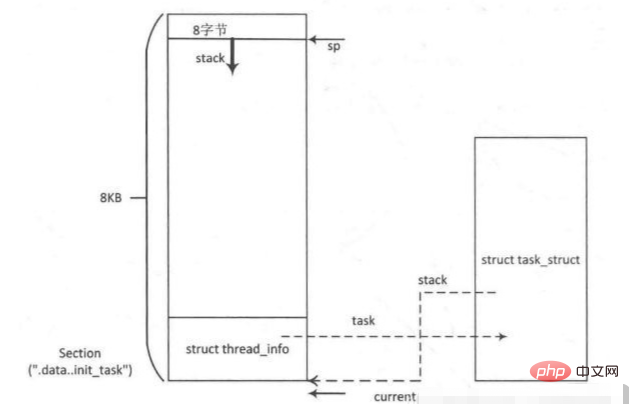Home >Operation and Maintenance >Linux Operation and Maintenance >Does Linux have kernel-level threads?
Does Linux have kernel-level threads?
- 青灯夜游Original
- 2022-11-11 14:20:322610browse
Linux has kernel-level threads, and Linux supports kernel-level multi-threading. The Linux kernel can be regarded as a service process (managing software and hardware resources, responding to various processes of user processes); the kernel requires multiple execution streams in parallel, and supports multi-threading in order to prevent possible blocking. A kernel thread is a clone of the kernel that can be used to handle a specific thing. The kernel is responsible for scheduling kernel threads. When one kernel thread is blocked, it does not affect other kernel threads.

#The operating environment of this tutorial: linux7.3 system, Dell G3 computer.
Threads are usually defined as different execution routes of code in a process. In terms of implementation, there are two types of threads: "user-level threads" and "kernel-level threads".
User threads refer to threads that are implemented in user programs without kernel support. They do not depend on the operating system core. Application processes use the thread library to provide functions for creating, synchronizing, scheduling, and managing threads to control user threads. . This kind of thread can even be implemented in operating systems like DOS, but the scheduling of threads needs to be completed by the user program, which is somewhat similar to the cooperative multitasking of Windows 3.x.
The other requires the participation of the kernel, which completes thread scheduling. It relies on the operating system core and is created and destroyed by the kernel's internal needs. Both models have their own advantages and disadvantages.
User threads require no additional kernel overhead, and the implementation of user-mode threads can be customized or modified to suit the requirements of special applications. However, when a thread is in a waiting state due to I/O, the entire process It will be switched to a waiting state by the scheduler, and other threads will not get a chance to run; while the kernel thread has no restrictions, which is conducive to taking advantage of the concurrency of multi-processors, but it takes up more system expenses.
Windows NT and OS/2 support kernel threads. Linux supports kernel-level multithreading.
Kernel-level threads in linux
1. Kernel thread overview
The Linux kernel can be regarded as a service process (a process that manages software and hardware resources and responds to various user processes)
The kernel requires multiple execution streams in parallel. In order to prevent possible blocking, it supports multi-threading.
A kernel thread is a clone of the kernel that can be used to handle a specific thing. The kernel is responsible for the scheduling of kernel threads. When one kernel thread is blocked, it does not affect other kernel threads.
Kernel threads are processes started directly by the kernel itself. Kernel threads actually delegate kernel functions to independent processes for execution, which execute in parallel with other "processes" in the kernel. Kernel threads are often called kernel daemons. In the current kernel, the kernel thread is responsible for the following work:
- Periodically synchronize the modified memory page with the page source block device
- Implement the transaction log of the file system
Kernel threads are created by the kernel, so kernel threads execute in kernel mode and can only access the kernel virtual address space and cannot access user space.
In Linux, all threads are implemented as processes, and there is no separate scheduling algorithm and data structure defined for threads. A process is equivalent to containing one thread, which is itself, multi-threaded, and the original thread is called the main thread. Threads, together they form a thread group.
The process has its own address space, so each process has its own page table, but the thread does not. It can only share the address space and page table of the main thread with other threads
2. Three data structures
Each process or thread consists of three important data structures, namely struct thread_info, struct task_struct and kernel stack.
The thread_info object stores the basic information of the process/thread. It and the kernel stack of the process/thread are stored in a space twice the page length in the kernel space. The thread_info structure is stored at the end of the address segment, and the remaining space is used as the kernel stack. The kernel uses the buddy system to allocate this space.

struct thread_info {
int preempt_count; /* 0 => preemptable, bug */
struct task_struct *task; /* main task structure */
__u32 cpu; /* cpu */};There is a struct task_struct *task in the thread_info structure, and task points to the task_struct of the thread or process Object, task_struct is also called task descriptor:
struct task_struct {
pid_t pid;
pid_t tgid;
void *stack;
struct mm_struct *mm, *active_mm;
/* filesystem information */
struct fs_struct *fs;
/* open file information */
struct files_struct *files;};#define task_thread_info(task) ((struct thread_info *)(task)->stack)- stack:是指向进程或者线程的thread_info
- mm:对象用来管理该进程/线程的页表以及虚拟内存区
- active_mm:主要用于内核线程访问主内核页全局目录
- pid:每个task_struct都会有一个不同的id,就是pid
- tgid:线程组领头线程的PID,就是主线程的pid
linux系统上虚拟地址空间分为两个部分:供用户态程序访问的虚拟地址空间和供内核访问的内核空间。每当内核执行上下文切换时,虚拟地址空间的用户层部分都会切换,以便匹配运行的进程,内核空间的部分是不会切换的。
3.内核线程创建
在内核版本linux-3.x以后,内核线程的创建被延后执行,并且交给名为kthreadd 2号线程执行创建过程,但是kthreadd本身是怎么创建的呢?过程如下:
pid_t kernel_thread(int (*fn)(void *), void *arg, unsigned long flags)
{
return do_fork(flags|CLONE_VM|CLONE_UNTRACED, (unsigned long)fn,
(unsigned long)arg, NULL, NULL);
}
pid = kernel_thread(kthreadd, NULL, CLONE_FS | CLONE_FILES);kthreadadd本身最终是通过do_fork实现的,do_fork通过传入不同的参数,可以分别用于创建用户态进程/线程,内核线程等。当kthreadadd被创建以后,内核线程的创建交给它实现。
内核线程的创建分为创建和启动两个部分,kthread_run作为统一的接口,可以同时实现,这两个功能:
#define kthread_run(threadfn, data, namefmt, ...) \
({ \
struct task_struct *__k \
= kthread_create(threadfn, data, namefmt, ## __VA_ARGS__); \
if (!IS_ERR(__k)) \
wake_up_process(__k); \
__k; \
})
#define kthread_create(threadfn, data, namefmt, arg...) \
kthread_create_on_node(threadfn, data, -1, namefmt, ##arg)
struct task_struct *kthread_create_on_node(int (*threadfn)(void *data),
void *data, int node,
const char namefmt[],
...)
{
DECLARE_COMPLETION_ONSTACK(done);
struct task_struct *task;
/*分配kthread_create_info空间*/
struct kthread_create_info *create = kmalloc(sizeof(*create),
GFP_KERNEL);
if (!create)
return ERR_PTR(-ENOMEM);
create->threadfn = threadfn;
create->data = data;
create->node = node;
create->done = &done;
/*加入到kthread_creta_list列表中,等待ktherad_add中断线程去创建改线程*/
spin_lock(&kthread_create_lock);
list_add_tail(&create->list, &kthread_create_list);
spin_unlock(&kthread_create_lock);
wake_up_process(kthreadd_task);
/*
* Wait for completion in killable state, for I might be chosen by
* the OOM killer while kthreadd is trying to allocate memory for
* new kernel thread.
*/
if (unlikely(wait_for_completion_killable(&done))) {
/*
* If I was SIGKILLed before kthreadd (or new kernel thread)
* calls complete(), leave the cleanup of this structure to
* that thread.
*/
if (xchg(&create->done, NULL))
return ERR_PTR(-EINTR);
/*
* kthreadd (or new kernel thread) will call complete()
* shortly.
*/
wait_for_completion(&done);
}
task = create->result;
.
.
.
kfree(create);
return task;
}kthread_create_on_node函数中:
- 首先利用kmalloc分配kthread_create_info变量create,利用函数参数初始化create
- 将create加入kthread_create_list链表中,然后唤醒kthreadd内核线程创建当前线程
- 唤醒kthreadd后,利用completion等待内核线程创建完成,completion完成后,释放create空间
下面来看下kthreadd的处理过程:
int kthreadd(void *unused)
{
struct task_struct *tsk = current;
/* Setup a clean context for our children to inherit. */
set_task_comm(tsk, "kthreadd");
ignore_signals(tsk);
set_cpus_allowed_ptr(tsk, cpu_all_mask);
set_mems_allowed(node_states[N_MEMORY]);
current->flags |= PF_NOFREEZE;
for (;;) {
set_current_state(TASK_INTERRUPTIBLE);
if (list_empty(&kthread_create_list))
schedule();
__set_current_state(TASK_RUNNING);
spin_lock(&kthread_create_lock);
while (!list_empty(&kthread_create_list)) {
struct kthread_create_info *create;
create = list_entry(kthread_create_list.next,
struct kthread_create_info, list);
list_del_init(&create->list);
spin_unlock(&kthread_create_lock);
create_kthread(create);
spin_lock(&kthread_create_lock);
}
spin_unlock(&kthread_create_lock);
}
return 0;
}kthreadd利用for(;;)一直驻留在内存中运行:主要过程如下:
- 检查kthread_create_list为空时,kthreadd让出cpu的执行权
- kthread_create_list不为空时,利用while循环遍历kthread_create_list链表
- 每取下一个链表节点后调用create_kthread,创建内核线程
static void create_kthread(struct kthread_create_info *create)
{
int pid;
/* We want our own signal handler (we take no signals by default). */
pid = kernel_thread(kthread, create, CLONE_FS | CLONE_FILES | SIGCHLD);
if (pid done, NULL);
if (!done) {
kfree(create);
return;
}
create->result = ERR_PTR(pid);
complete(done);
}
}可以看到内核线程的创建最终还是和kthreadd一样,调用kernel_thread实现。
static int kthread(void *_create)
{
.
.
.
.
/* If user was SIGKILLed, I release the structure. */
done = xchg(&create->done, NULL);
if (!done) {
kfree(create);
do_exit(-EINTR);
}
/* OK, tell user we're spawned, wait for stop or wakeup */
__set_current_state(TASK_UNINTERRUPTIBLE);
create->result = current;
complete(done);
schedule();
ret = -EINTR;
if (!test_bit(KTHREAD_SHOULD_STOP, &self.flags)) {
__kthread_parkme(&self);
ret = threadfn(data);
}
/* we can't just return, we must preserve "self" on stack */
do_exit(ret);
}kthread以struct kthread_create_info 类型的create为参数,create中带有创建内核线程的回调函数,以及函数的参数。kthread中,完成completion信号量的处理,然后schedule让出cpu的执行权,等待下次返回 时,执行回调函数threadfn(data)。
4.内核线程的退出
线程一旦启动起来后,会一直运行,除非该线程主动调用do_exit函数,或者其他的进程调用kthread_stop函数,结束线程的运行。
int kthread_stop(struct task_struct *k)
{
struct kthread *kthread;
int ret;
trace_sched_kthread_stop(k);
get_task_struct(k);
kthread = to_live_kthread(k);
if (kthread) {
set_bit(KTHREAD_SHOULD_STOP, &kthread->flags);
__kthread_unpark(k, kthread);
wake_up_process(k);
wait_for_completion(&kthread->exited);
}
ret = k->exit_code;
put_task_struct(k);
trace_sched_kthread_stop_ret(ret);
return ret;
}如果线程函数正在处理一个非常重要的任务,它不会被中断的。当然如果线程函数永远不返回并且不检查信号,它将永远都不会停止。在执行kthread_stop的时候,目标线程必须没有退出,否则会Oops。所以在创建thread_func时,可以采用以下形式:
thread_func()
{
// do your work here
// wait to exit
while(!thread_could_stop())
{
wait();
}
}
exit_code()
{
kthread_stop(_task); //发信号给task,通知其可以退出了
}如果线程中在等待某个条件满足才能继续运行,所以只有满足了条件以后,才能调用kthread_stop杀掉内核线程。
5.内核线程使用
#include "test_kthread.h"
#include <linux>
#include <linux>
#include <linux>
#include <linux>
#include <linux>
static struct task_struct *test_thread = NULL;
unsigned int time_conut = 5;
int test_thread_fun(void *data)
{
int times = 0;
while(!kthread_should_stop())
{
printk("\n printk %u\r\n", times);
times++;
msleep_interruptible(time_conut*1000);
}
printk("\n test_thread_fun exit success\r\n\n");
return 0;
}
void register_test_thread(void)
{
test_thread = kthread_run(test_thread_fun , NULL, "test_kthread" );
if (IS_ERR(test_thread)){
printk(KERN_INFO "create test_thread failed!\n");
}
else {
printk(KERN_INFO "create test_thread ok!\n");
}
}
static ssize_t kthread_debug_start(struct device *dev, struct device_attribute *attr, char *buf)
{
register_test_thread();
return 0;
}
static ssize_t kthread_debug_stop(struct device *dev, struct device_attribute *attr, char *buf)
{
kthread_stop(test_thread);
return 0;
}
static DEVICE_ATTR(kthread_start, S_IRUSR, kthread_debug_start,NULL);
static DEVICE_ATTR(kthread_stop, S_IRUSR, kthread_debug_stop,NULL);
struct attribute * kthread_group_info_attrs[] =
{
&dev_attr_kthread_start.attr,
&dev_attr_kthread_stop.attr,
NULL,
};
struct attribute_group kthread_group =
{
.name = "kthread",
.attrs = kthread_group_info_attrs,
};</linux></linux></linux></linux></linux>
相关推荐:《Linux视频教程》
The above is the detailed content of Does Linux have kernel-level threads?. For more information, please follow other related articles on the PHP Chinese website!

